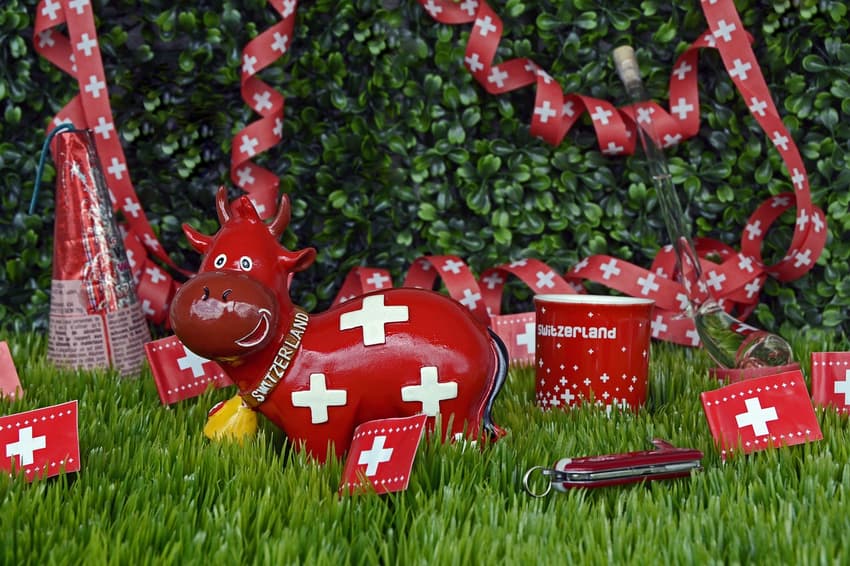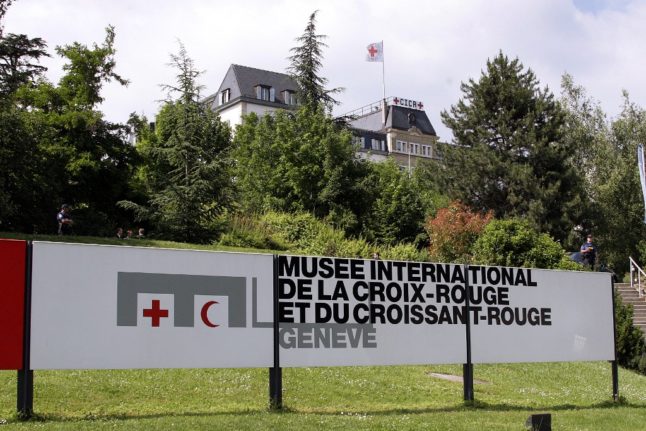EXPLAINED: Where you can learn about Swiss history on August 1st

There are plenty of National Day activities held in practically all of Switzerland’s communities on August 1st, including brunches and barbecues. But none of them have much to do with the country’s history.
If you are all brunched-out and can’t stomach yet another grilled cervelat, there are other activities you can do on Switzerland’s National Day.
For instance, unless you know everything about the country’s past — and not just the bit about the cantons of Uri, Schwyz and Nidwalden signing the Federal Charter on the Rütli meadow in 1291 — then August 1st may be a perfect time to learn about the defining moments in Switzerland’s history.
This is where you can explore Switzerland's past.
Parliament
The Federal Building in Bern, which is the seat of the Federal Council and both chambers of the parliament, will be opening its doors to visitors on August 1st from 8.30am.
During the day, the Council of States President Brigitte Häberli-Koller and National Council President Martin Candinas will be in the National Council Chamber for a moderated discussion with the public.
In Room 4, there will be showings of SESSION, a film documenting four MAGNUM photographers as they worked in the Parliament Building. At the same time, musicians will be playing at various locations in and around the Parliament Building.
This is a great opportunity to visit the place where all the legislative and executive political processes are happening on daily basis.

Parliament building in Bern will open to public. Photo by Fabrice COFFRINI / AFP
Swiss National Museum(s)
Split between the German and French-speaking parts of Switzerland, the museums are located both in Zurich and in Prangins in canton Vaud.
Both have, aside from temporary displays from various artists, the permanent exhibit dedicated to Switzerland’s history.
Aside from re-tracing the evolution and development of direct democracy, the exhibit also covers such topics as Swiss mercenaries of the Middle Ages, the role of women in Swiss society, and the history of immigration.
If you go to the Prangins site, located in an 18th-century castle overlooking Lake Geneva, you will also have the possibility of visiting the country’s largest historical kitchen garden on the museum’s land.
According to the museum’s website, the 5,500 sqquare-metre garden boats “almost 200 species and varieties of fruits, vegetables, aromatic and utilitarian plants that were present in the region in the 18th century are grown in accordance with organic farming principles."
Both national museums are open from 10 am on August 1st.
Tell Museum
Okay, so Switzerland’s most famous apple-shooter was not a real person — as far as we know.
But real or not, William Tell is a big part of Switzerland’s fight for its sovereignty, as he is credited in the legend.
The Tell Museum in Bürglen, a town located — appropriately enough, in Uri, one of the three founding cantons — explores the mystery of the Swiss folk hero.
The museum’s purpose is "collecting, storing and preserving documents, objects and historical, artistic and traditional depictions of Tell as well as of events connected to the founding history of the Swiss Confederacy,” its website indicates.
It is opened from 10 am on August 1st.

Swiss folk hero, William Tell.Image by Marlon Trottmann from Pixabay
The Red Cross Museum
The International Red Cross and Red Crescent Museum, as it is officially called, is located, logically, in Geneva, because that is where the founder of the movement, Henri Dunant was from.
Both Dunant and the movement are therefore closely associated with Switzerland.
The museum documents the history of the world’s largest humanitarian movement.
Various exhibits remind visitors of the importance of international humanitarian efforts from the 19th century (when the Red Cross was born) to modern times.
Opened from 10 am.

The entrance of the International Committee of the Red Cross (ICRC) Museum is seen with the ICRC headquarters as background. Photo by FABRICE COFFRINI / AFP
Ballenberg
The vast, open-air museum in Ballenberg, Bern, features different facets of Switzerland’s architectural and folkloric traditions.
The old farmhouses you see while strolling around the huge park are original models, dismantled piece by piece in their villages, brought to Ballenberg, and carefully re-assembled.
There are also indigenous plants and crops that have been cultivated here, and over 200 native livestock species.
Impressions from the Ballenberg museum near Interlaken. pic.twitter.com/pXskvFjDEu
— Caroline (@BeautyAndTheCat) June 12, 2022
You can also see traditional handicrafts coming alive, including basket-weaving, braiding, and spinning.
All these museums will give different glimpses of Switzerland's history, and that is what August 1st is all about..
Comments
See Also
If you are all brunched-out and can’t stomach yet another grilled cervelat, there are other activities you can do on Switzerland’s National Day.
For instance, unless you know everything about the country’s past — and not just the bit about the cantons of Uri, Schwyz and Nidwalden signing the Federal Charter on the Rütli meadow in 1291 — then August 1st may be a perfect time to learn about the defining moments in Switzerland’s history.
This is where you can explore Switzerland's past.
Parliament
The Federal Building in Bern, which is the seat of the Federal Council and both chambers of the parliament, will be opening its doors to visitors on August 1st from 8.30am.
During the day, the Council of States President Brigitte Häberli-Koller and National Council President Martin Candinas will be in the National Council Chamber for a moderated discussion with the public.
In Room 4, there will be showings of SESSION, a film documenting four MAGNUM photographers as they worked in the Parliament Building. At the same time, musicians will be playing at various locations in and around the Parliament Building.
This is a great opportunity to visit the place where all the legislative and executive political processes are happening on daily basis.

Swiss National Museum(s)
Split between the German and French-speaking parts of Switzerland, the museums are located both in Zurich and in Prangins in canton Vaud.
Both have, aside from temporary displays from various artists, the permanent exhibit dedicated to Switzerland’s history.
Aside from re-tracing the evolution and development of direct democracy, the exhibit also covers such topics as Swiss mercenaries of the Middle Ages, the role of women in Swiss society, and the history of immigration.
If you go to the Prangins site, located in an 18th-century castle overlooking Lake Geneva, you will also have the possibility of visiting the country’s largest historical kitchen garden on the museum’s land.
According to the museum’s website, the 5,500 sqquare-metre garden boats “almost 200 species and varieties of fruits, vegetables, aromatic and utilitarian plants that were present in the region in the 18th century are grown in accordance with organic farming principles."
Both national museums are open from 10 am on August 1st.
Tell Museum
Okay, so Switzerland’s most famous apple-shooter was not a real person — as far as we know.
But real or not, William Tell is a big part of Switzerland’s fight for its sovereignty, as he is credited in the legend.
The Tell Museum in Bürglen, a town located — appropriately enough, in Uri, one of the three founding cantons — explores the mystery of the Swiss folk hero.
The museum’s purpose is "collecting, storing and preserving documents, objects and historical, artistic and traditional depictions of Tell as well as of events connected to the founding history of the Swiss Confederacy,” its website indicates.
It is opened from 10 am on August 1st.

The Red Cross Museum
The International Red Cross and Red Crescent Museum, as it is officially called, is located, logically, in Geneva, because that is where the founder of the movement, Henri Dunant was from.
Both Dunant and the movement are therefore closely associated with Switzerland.
The museum documents the history of the world’s largest humanitarian movement.
Various exhibits remind visitors of the importance of international humanitarian efforts from the 19th century (when the Red Cross was born) to modern times.
Opened from 10 am.

Ballenberg
The vast, open-air museum in Ballenberg, Bern, features different facets of Switzerland’s architectural and folkloric traditions.
The old farmhouses you see while strolling around the huge park are original models, dismantled piece by piece in their villages, brought to Ballenberg, and carefully re-assembled.
There are also indigenous plants and crops that have been cultivated here, and over 200 native livestock species.
Impressions from the Ballenberg museum near Interlaken. pic.twitter.com/pXskvFjDEu
— Caroline (@BeautyAndTheCat) June 12, 2022
You can also see traditional handicrafts coming alive, including basket-weaving, braiding, and spinning.
All these museums will give different glimpses of Switzerland's history, and that is what August 1st is all about..
Join the conversation in our comments section below. Share your own views and experience and if you have a question or suggestion for our journalists then email us at [email protected].
Please keep comments civil, constructive and on topic – and make sure to read our terms of use before getting involved.
Please log in here to leave a comment.